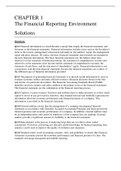CHAPTER 1 The Financial Reporting Environment Solutions Questions Q1-1 Financial information is a much broader concept than simply the financial statements and footnotes to the financial statements . Financial information include s items such as the Presiden t‘s letter to the owners, management‘s discussion and analysis, the auditors‘ report, the management report and press releases. Of course, the basic financial statements and footnotes are included in the term financial information. The basic financial stat ements are: the balance sheet (also referred to as the statement of financial position), the statement of comprehensive income (also referred to as the statement of net income and the statement of comprehensive income ), the statement of cash flows, and the statement of shareholders‘ equity. Financial information is not synonymous with the term financial statements because the financial statements are a subset of the different types of financial information provided. Q1-2 The purpose of generating financial statements is to provide useful information to users to evaluate economic entities and make efficient resource allocation decisions based on the risks and returns of a particular investment. The Financial Accounting Standards Board (FASB) identifies invest ors, lenders and other creditors as the primary users of the financial statements. The f inancial statements are the culmination of the financial reporting process. Q1-3 Capital is a scarce resource. Investors and creditors have to make decisions as to how much capital to invest in any given entity; therefore, they demand relevant and faithfully representative information about the economic performance and financial position of a company. This information is provided in the financial statements. Q1-4 Exter nal auditors ensure that the management of a company has prepared financial statements in accordance with Generally Accepted Accounting Principles and fairly present the financial position and economic performance of a company. In addition, external audito rs must be an independent party and cannot be employees of the company they are auditing. External auditors provide a significant amount of credibility to the financial statements. Q1-5 Data analytics is the process of analyzing large data sets in order to draw useful conclusions. It involves converting raw data into useful knowledge. In financial reporting, data analytics can be used to improve the quality of estimates and valuations. Q1-6 Standard setters create accounting concepts, rules, and guidelines to ensure that financial statements accurately present the economic performance a nd financial position of a firm. The standards encourage transparent and truthful reporting. 1-2 S O L U T I O N S M A N U A L F O R I N T E R M E D I A T E A C C O U N T ING © 20 21 Pearson Education, Inc. Q1-7 U.S. companies listed on U.S. stock exchanges do not have the option to rep ort under IFRS. However, foreign companies that trade in the U.S. exchanges can report under IFRS. The SEC permits the use of IFRS -based financial statements by international companies with shares trading on U.S. stock exchanges. Q1-8 The FASB seeks and we lcomes comments from all parties in the financial reporting process including managers, investors, accountants, preparers, creditors, lenders, financial statement users, governmental agencies , financial analysts, industry groups, and auditors. FASB also re ceives feedback from public roundtable discussions, public meetings, the FASAC , the Private Company Council, and EITF. Q1-9 Yes, the promulgation of financial accounting standards is a political process . There are several groups that influence the standard setting process. The standard setting process is a political process that is affected by the impact of several lobbying groups. The government, through the SEC, influences accounting standards. The SEC has the authority to issue accounting standards but h as assigned this responsibility to the private sector. Nonetheless, the SEC can exert pressure on the FASB to issue accounting standards and veto the standards promulgated by the FASB. Auditing firms, the corporate sector , creditors, financial analysts, th e financial community, accounting organizations, industry groups, and investors can influence the FASB by written comments about Exposure Drafts and participation in public meetings and public roundtables regarding a proposed financial reporting standard. Q1-10 A principles -based standard is consistent with a theoretical framework. In contrast, a rules -based standard does not necessarily rely on a consistent theoretical framework. Rather, it contains more specific and prescriptive rules. Q1-11 Recently, the FASB has taken an asset/liability approach in setting standards. With this approach, a transaction is recorded based on whether an asset or liability is created. Another trend has been the movement toward the use of fair value measurements as an alternati ve to historical cost. FASB has also focused on the promulgation of principles -based standards instead of rules -based standards. Brief Exercises Solution to BE1 -1 General -purpose financial statements provide general financial information about an entity t hat will be useful to many types of users. General -purpose financial statements provide information to a wide spectrum of user groups: investors, creditors, financial analysts, customers, employees, competitors, suppliers , unions, and government agencies. Most financial information in general purpose financial statements is provided to satisfy users with limited ability or authority to obtain additional information, which includes investors and creditors. The Financial Accounting Standards Board (FASB) iden tifies investors, lenders, and other creditors as the primary users of the financial statements. C H A P T E R 1 T H E F I N A N C I A L R E P O R T I N G E N V I R O N M E N T 1-3 © 20 21 Pearson Education, Inc. Solution to BE1 -2 Financial accounting is the process of identifying, measuring, and communicating financial information about an economic entity to various us er groups within the legal, economic, political, and social environment. This definition contains four major elements: 1. Financial information; 2.Economic entity; 3. User groups and 4. Legal, economic, political, and social environment Solution to BE1 -3 Financial Statement Users and Other Parties Role 10 Equity Investors 1 Creditors 5 Financial Analysts 8 Employees and Labor Unions 2 Suppliers and Customers 7 Government Agencies 3 Competitors 4 External Auditors 6 Internal Auditors 11 Regula tory Bodies 9 Professional Organizations 10. Are s hareholders of the company. 1. Are b anks and other financial institutions that lend money to the company. 5. Use financial information to review and analyze reported results of the companies they cover and make investment recommendations. 8. Use financial information during negotiation of new labor agreements and compensation contracts. 2. Use financial statements to determine whether to conduct business or purchase products from a company. 7. Review the financial statements of publicly traded companies for a variety of reasons that are in the public interest. 3. Use financial information to determine their market position relative to the reporting entity and to attempt to identify future strateg ies of the reporting entity. 4. Are i ndependent of the company and responsible for ensuring that management prepares and issues financial statements that comply with accounting standards and fairly present the financial position and economic performance of the company. 6. Are e mployees of the company serving in an advisory role to management. They provide information to management regarding the company‘s operations and proper functioning of its internal controls. 11. Protect investors and oversee the accounting and auditing standard setting processes. 9. Support accounting professionals throughout their 1-4 S O L U T I O N S M A N U A L F O R I N T E R M E D I A T E A C C O U N T ING © 20 21 Pearson Education, Inc. careers by providing training, professional skills development, and other resources. Solution to BE1-4 Financial statement users and why each would use the financial statements are summarized below: 1. Equity investors - Equity investors buy stock in the company, that is, they purchase a percentage of the company itself. The financial statements help them make investment decisions. 2. Creditors - Creditors loan money to the company . The financial statements help them assess the creditworthiness of the company , and whether principal and interest will be repaid . 3. Competitors - Competitors use financial statements to determine their market position relative to the reporting entity.





